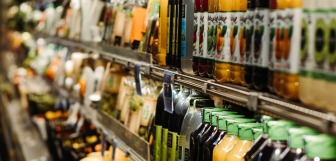What Is Safety Stock?
As a business owner, you’ll know one of the worst experiences is not having an item in stock that a customer asks for.
This experience can be avoided with safety stock, a back-up of products so that no change in supply can affect your ability to deliver for your customers.
What safety stock does in supply chain management
Safety stock is essentially ordering or purchasing more of a product than you expect to need to ensure a basic service level available for trade. It is also known as reserve or buffer stock/inventory. Regardless of the term used, each refers to the practice of ordering excess products, a practice common in many different industries.
Given the complexity of supply chains in many forms of business, it is likely that everyone will experience fluctuations and loss of reliable supply at one time or another. This can happen due to poor weather conditions or “acts of God”, production difficulties, loss of raw materials, strikes, or any other eventualities.
But safety stock can protect against more than lack of availability. In many industries, prices can fluctuate wildly. For instance, Government policy or market forces can have a large effect on supply and demand. Excess inventory provides the business with a degree of agency over whether or not to accept any changes in inventory costs which an enterprise in desperate need of a product doesn’t have.
This achieves two main, valuable goals: it maximizes revenue by ensuring the business does not lose sales due to a rise in customer demand leading to stock shortages. No customers will not be left short even if the demand of the product leads to higher sales in a short period of time. But it also protects the business's reputation and helps provide a reliable service to impress customers, with run-on effects like higher customer loyalty.
Managing and running your business is easier with technology that has every tool you need. Epos Now POS (point of sale) systems have hardware and software to suit your needs, generating hundreds of reports to help you know more about your business, and feel certain when the price is right.
Epos Now customers can:
- Create bespoke transaction setups on secure, speedy software to shave time off the sales process
- Choose from hundreds of apps and integrable partner programs to run accounting, marketing and other back-of-house functions in a way that suits you
- Access reports and manage prices and inventory on-site or off, night or day, through cloud technology
- Purchase all the retail or hospitality you need, hardware and software and receive expert advice and support around the clock to get the best out of your business

How much safety stock should be carried?
After considering the benefits of safety stock, one might think that getting large amounts of reserves is a great way of securing business. However, most businesses do not do this for the simple reason that high inventory levels also have their costs.
In part, those costs are literal as reinvesting capital in larger inventory holdings means not investing elsewhere. In addition, storage/warehouse space is required for the extra products, which brings a further expense.
Spoilage or wastage is also likely, even in products that don’t degrade or have a sell-by date. This may occur due to clumsiness, environment, or in rare circumstances the product might even become obsolete, losing its sale value.
As a result of the delicately balanced cost-benefit impact, businesses of all colours put a lot of thought into how to calculate safety stock levels. They do this using factors such as demand variability and average lead time.
What is safety stock formula?
The lead time in production means how long it takes to complete the manufacturing process, while demand is how many people are buying the manufactured product. This is crucial to stock calculation as a change in demand or lead time is what will likely lead to shortages. Although most smaller businesses will not be as involved further down the supply chain to use these factors in their calculations.
Different industries have a different standard deviation and therefore fluctuate more or less with minimum or maximum lead time, and demand, shifting different amounts. Consequently, the amount of safety stock needed varies between industries and different formulas exist for inventory management.

Traditional safety stock formula
There is a standard, accepted formula for businesses looking to calculate a reserve stock level. It uses sales data to calculate how much compensation would be required following an increase from the average daily sales to maximum recorded sales. It looks like this:
(Maximum sales - average sales) x lead time[1]
Accepting that the average retailer or restauranteur is not involved in manufacturing, lead time can be interpreted as how frequently the business restocks. In a sense, the regularity of trips to the wholesaler is how long a shop takes to “produce” a product.
Fixed safety stock
A fixed safety stock is the most basic method managers can use to keep additional product. This involves maintaining a cycling stock level with a secondary, static figure to be kept in reserve.
For instance, a business might sell fizzy drinks, and may keep one tray (24 cans) of each product and two trays (48 cans) of its bestseller as safety stock. Stock can still be rotated, so there is little danger of wastage, but if the weather is nice and sales rise, the safety stock will ensure all products are available.
There are numerous other methods for different situations and industries including the Heizer and Render formula, the Greasley formula, and time-based calculations. Choosing the right one that suits your business could have a significant impact on the effectiveness of your safety stock strategy[2].
When to use buffer stock
Safety stock comes with its share of pros and cons, so as with many business strategies, can be valuable when applied correctly. Products that receive a lower turnover or are less essential to the business or to consumers don’t necessarily need the extra security of additional stock. But there are many occasions when a business running out of a product will cause more significant losses in revenue and reputation.
Products that a business is known for, a restaurant with a specialty dish, a retailer with a successful promotion or unique product, will cause greater disappointment to customers. It may be that customers travelled to the business purely for one product or another, so running out will cause great frustration to customers who may look elsewhere as a result.
Never run out of stock with the latest POS inventory management system
Epos Now POS systems are designed with all the functionality the retail and hospitality industries could dream of. Every Epos Now customer benefits from state-of-the-art stock control software with front-of-house and back-office stocktake capabilities and access control.
Epos Now reports have detailed stock and sales information including bestsellers, non-selling stock, sales by time period including year-on-year comparisons. If even your safety stock is running low, minimum stock levels can prompt email alerts to notify you when a call to the supplier is needed.
Customers can also:
- Gain every advantage with hundreds of apps and partnerships with the best software in every industry
- Sell safely and speedily with the latest transaction technology
- Use Epos Now Payments to incorporate card processing into your POS with a simpler, easier style
- Manage their business stress-free with cloud technology that gives you instant access to the latest business data, from anywhere in the world!
To find out more about Epos Now solutions, submit your details below and speak to a member of our expert team.
With it's own in-built inventory system, Epos Now can streamline your business processes better than ever before, leaving you free to spend more time building your business.




